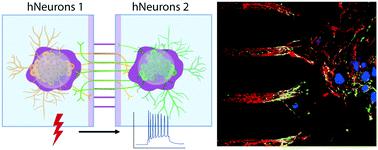Our official English website, www.x-mol.net, welcomes your
feedback! (Note: you will need to create a separate account there.)
Compartmentalized microfluidic chambers enable long-term maintenance and communication between human pluripotent stem cell-derived forebrain and midbrain neurons
Lab on a Chip ( IF 6.1 ) Pub Date : 2021-08-18 , DOI: 10.1039/d1lc00505g Ziqiu Tong 1 , Eunbi Kwak 1 , Alita Aguiar 1 , Bo Peng 2 , Colin W Pouton 1 , Nicolas H Voelcker 1, 2, 3 , John M Haynes 4
Lab on a Chip ( IF 6.1 ) Pub Date : 2021-08-18 , DOI: 10.1039/d1lc00505g Ziqiu Tong 1 , Eunbi Kwak 1 , Alita Aguiar 1 , Bo Peng 2 , Colin W Pouton 1 , Nicolas H Voelcker 1, 2, 3 , John M Haynes 4
Affiliation

|
Compartmentalized microfluidic devices are becoming increasingly popular and have proven to be valuable tools to probe neurobiological functions that are inherently difficult to study using traditional approaches. The ability of microfluidic devices to compartmentalize neurons offers considerable promise for disease modeling and drug discovery. Rodent cortical neurons/neural progenitors are commonly used in such studies but, while these cells mature rapidly, they do not possess the same receptors, ion channels and transport proteins found in human cortical neurons. Human pluripotent stem cell derived neurons offer a human phenotype, but their slow maturation offsets this phenotypic advantage, particularly over long-term culture where overgrowth and subsequent death of neurons may be a problem. In this work, we integrate the use of Matrigel as a 3D cell culture scaffold that enables high cell seeding density over a small fraction of the culture surface. This approach, in an open chamber microfluidic system, enables culture over a five-month period without the use of growth inhibitors. Matrigel was also uniquely utilized to hinder agonist diffusion across microchannels. We demonstrate the development of neuron-to-neuron communication networks by showing that electrical stimulation or the unilateral addition of agonists to one chamber resulted in activation of neurons in the adjacent chamber. Lastly, using a delayed neuron seeding strategy, we show that we can foster essentially one-way communication between separate populations of human forebrain and midbrain dopaminergic neuron containing cultures.
中文翻译:

分隔微流体室使人类多能干细胞衍生的前脑和中脑神经元之间的长期维护和交流成为可能
分隔的微流体设备正变得越来越流行,并且已被证明是探索神经生物学功能的宝贵工具,而这些功能本质上很难使用传统方法进行研究。微流体装置划分神经元的能力为疾病建模和药物发现提供了相当大的希望。啮齿动物皮质神经元/神经祖细胞通常用于此类研究,但是,虽然这些细胞成熟迅速,但它们不具有在人类皮质神经元中发现的相同受体、离子通道和转运蛋白。人类多能干细胞衍生的神经元提供人类表型,但它们的缓慢成熟抵消了这种表型优势,特别是在长期培养中,神经元过度生长和随后的死亡可能是一个问题。在这项工作中,我们整合使用 Matrigel 作为 3D 细胞培养支架,在培养表面的一小部分实现高细胞接种密度。这种方法在开放室微流体系统中,可以在不使用生长抑制剂的情况下培养超过五个月的时间。Matrigel 还被独特地用于阻止激动剂跨微通道扩散。我们通过显示电刺激或单方面向一个腔室添加激动剂导致相邻腔室中的神经元激活来证明神经元到神经元通信网络的发展。最后,使用延迟神经元播种策略,我们表明我们可以促进人类前脑和中脑含有多巴胺能神经元的不同群体之间的基本单向交流。
更新日期:2021-09-06
中文翻译:

分隔微流体室使人类多能干细胞衍生的前脑和中脑神经元之间的长期维护和交流成为可能
分隔的微流体设备正变得越来越流行,并且已被证明是探索神经生物学功能的宝贵工具,而这些功能本质上很难使用传统方法进行研究。微流体装置划分神经元的能力为疾病建模和药物发现提供了相当大的希望。啮齿动物皮质神经元/神经祖细胞通常用于此类研究,但是,虽然这些细胞成熟迅速,但它们不具有在人类皮质神经元中发现的相同受体、离子通道和转运蛋白。人类多能干细胞衍生的神经元提供人类表型,但它们的缓慢成熟抵消了这种表型优势,特别是在长期培养中,神经元过度生长和随后的死亡可能是一个问题。在这项工作中,我们整合使用 Matrigel 作为 3D 细胞培养支架,在培养表面的一小部分实现高细胞接种密度。这种方法在开放室微流体系统中,可以在不使用生长抑制剂的情况下培养超过五个月的时间。Matrigel 还被独特地用于阻止激动剂跨微通道扩散。我们通过显示电刺激或单方面向一个腔室添加激动剂导致相邻腔室中的神经元激活来证明神经元到神经元通信网络的发展。最后,使用延迟神经元播种策略,我们表明我们可以促进人类前脑和中脑含有多巴胺能神经元的不同群体之间的基本单向交流。











































 京公网安备 11010802027423号
京公网安备 11010802027423号